Abstract
BACKGROUND: The factors leading to chronic hypercapnia and rapid shallow breathing in patients with severe chronic obstructive pulmonary disease (COPD) are not completely understood. In this study the interrelations between chronic carbon dioxide retention, breathing pattern, dyspnoea, and the pressure required for breathing relative to inspiratory muscle strength in stable COPD patients with severe airflow obstruction were studied. METHODS: Thirty patients with COPD in a clinically stable condition with forced expiratory volume in one second (FEV1) of < 1 litre were studied. In each patient the following parameters were assessed: (1) dyspnoea scale rating, (2) inspiratory muscle strength by measuring minimal pleural pressure (PPLmin), and (3) tidal volume (VT), flow, pleural pressure swing (PPLsw), total lung resistance (RL), dynamic lung elastance (ELdyn), and positive end expiratory alveolar pressure (PEEPi) during resting breathing. RESULTS: Arterial carbon dioxide tension (PaCO2) related directly to RL/PPLmin, and ELdyn/PPLmin, and inversely to VT and PPLmin. There was no relationship between PaCO2 and functional residual capacity (FRC), total lung capacity (TLC), or minute ventilation. PEEPi was similar in eucapnic and hypercapnic patients. Expressing PaCO2 as a combined function of VT and PPLmin (stepwise multiple regression analysis) explained 71% of the variance in PaCO2. Tidal volume was directly related to inspiratory time (TI), and TI was inversely related to the pressure required for breathing relative to inspiratory muscle strength (PPLsw, %PPLmin). There was an association between the severity of dyspnoea and both the increase in PPLsw (%PPLmin) and the shortening in TI. CONCLUSIONS: The results indicate that, in stable patients with COPD with severe airflow obstruction, hypercapnia is associated with shallow breathing and inspiratory muscle weakness, and rapid and shallow breathing appears to be linked to both a marked increase in the pressure required for breathing relative to inspiratory muscle strength and to the severity of the breathlessness.
Full text
PDF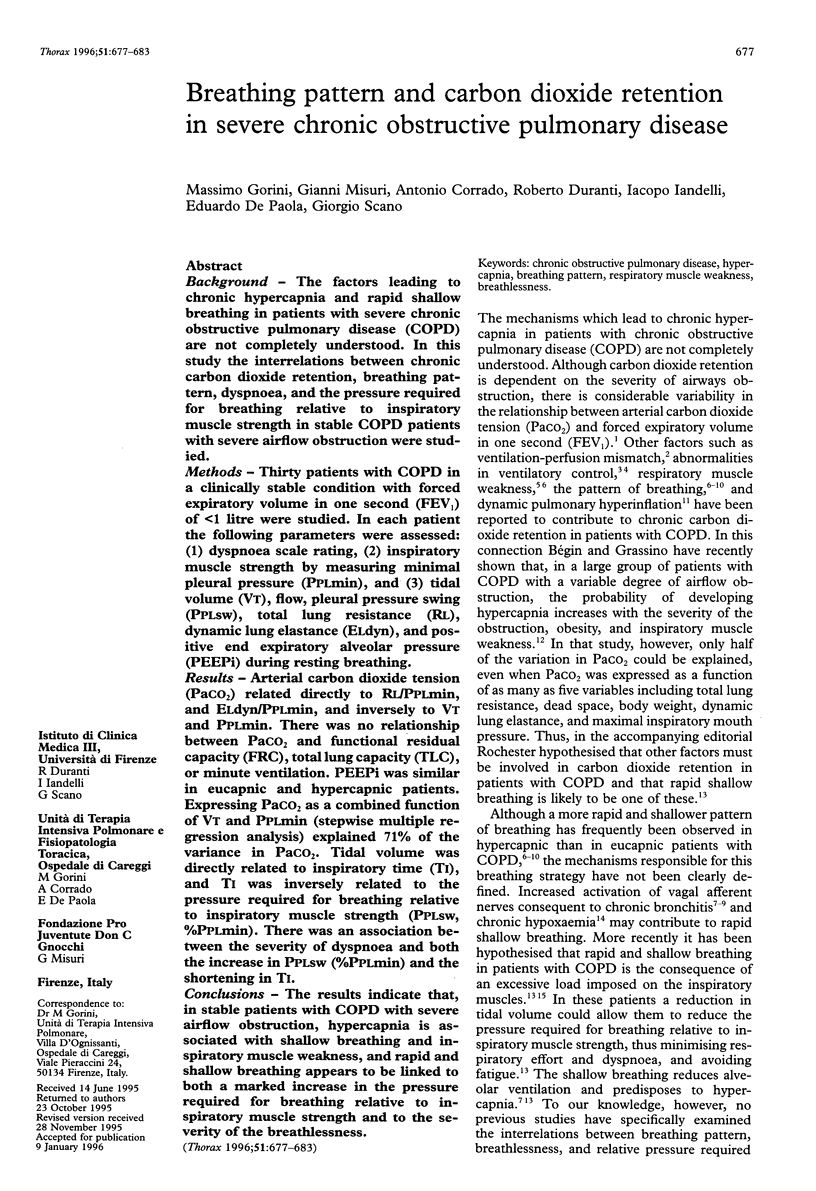
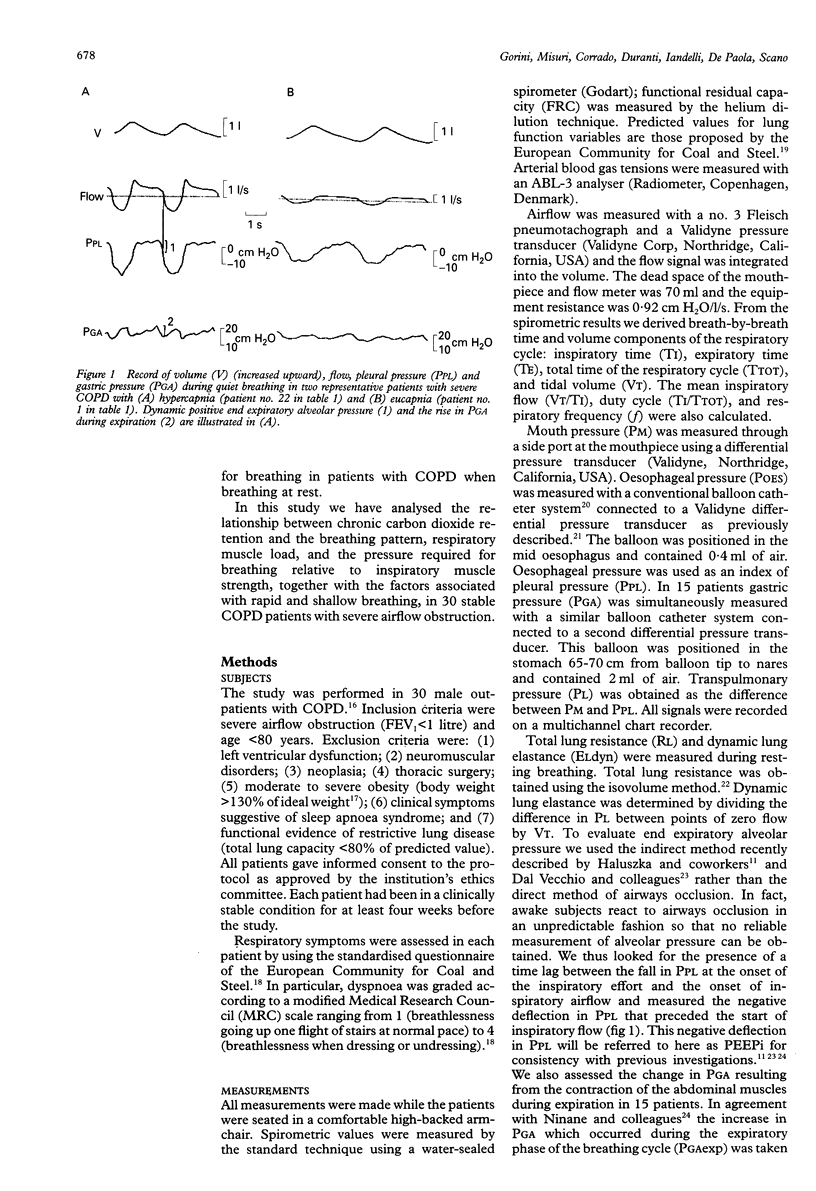


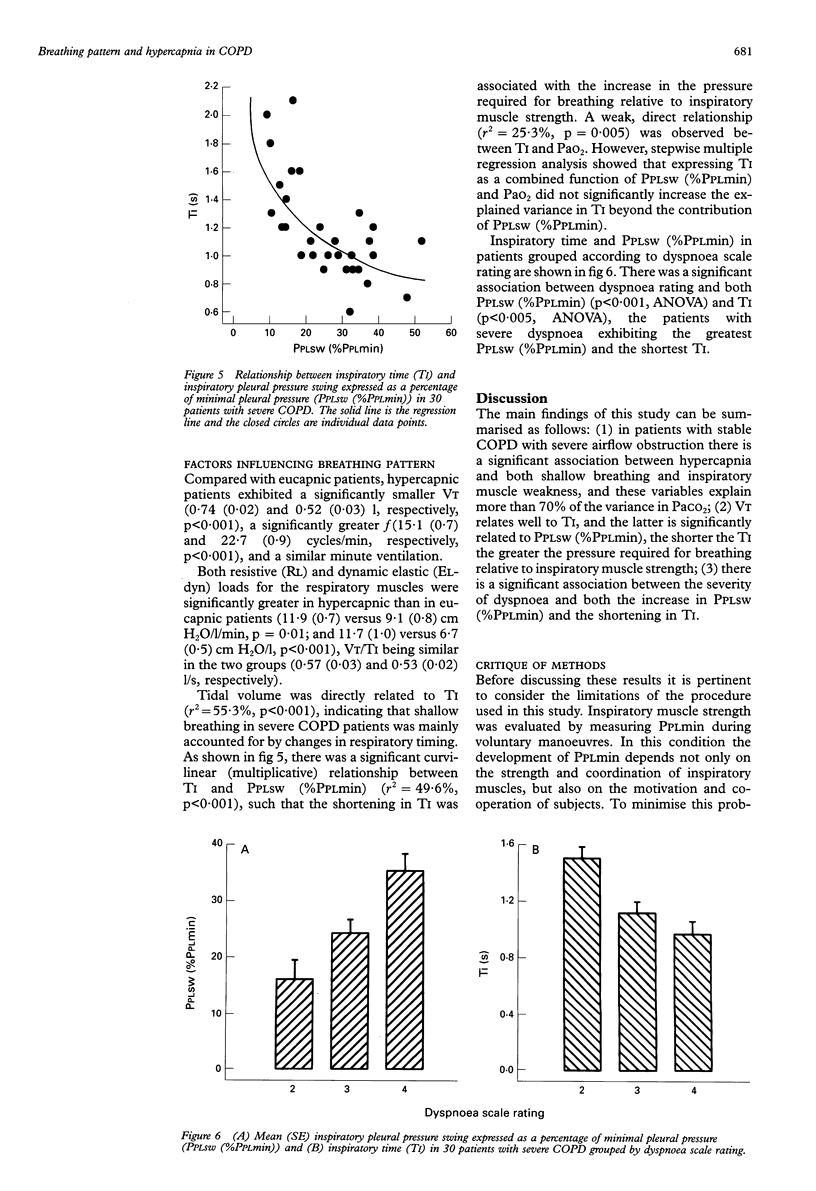
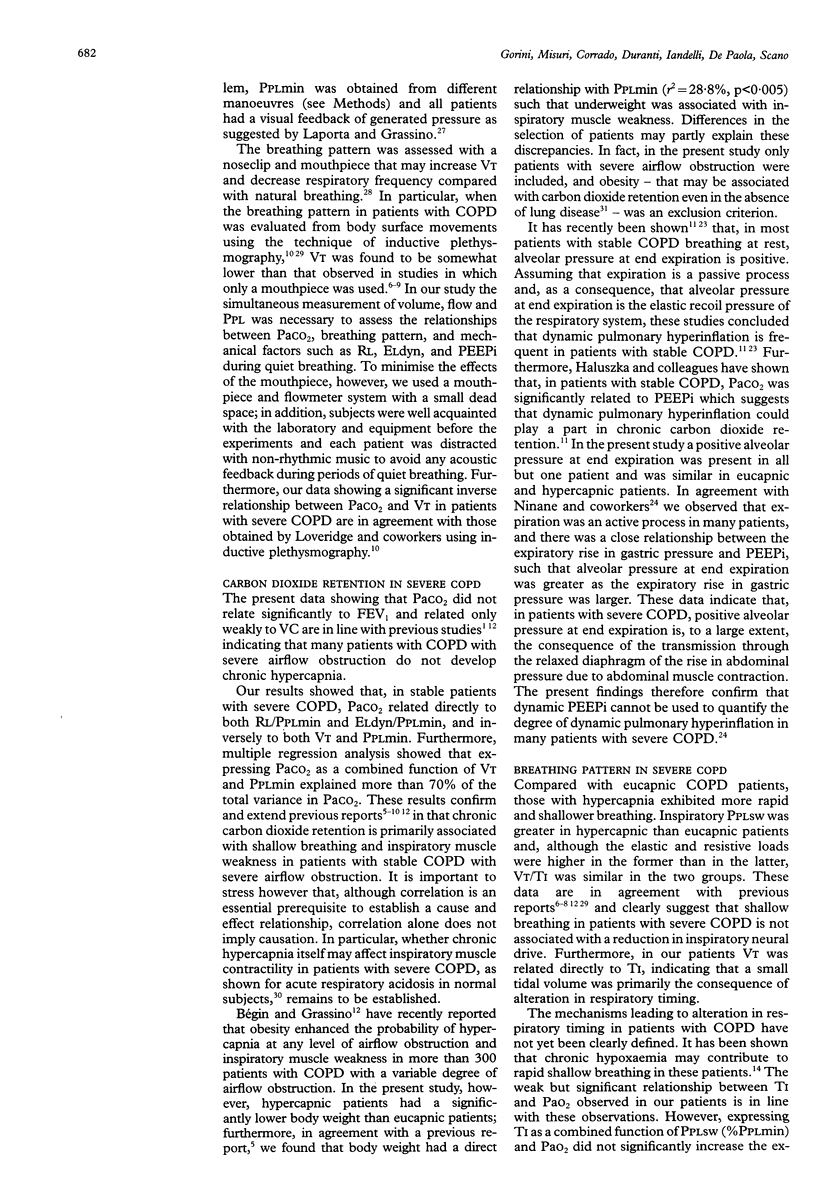
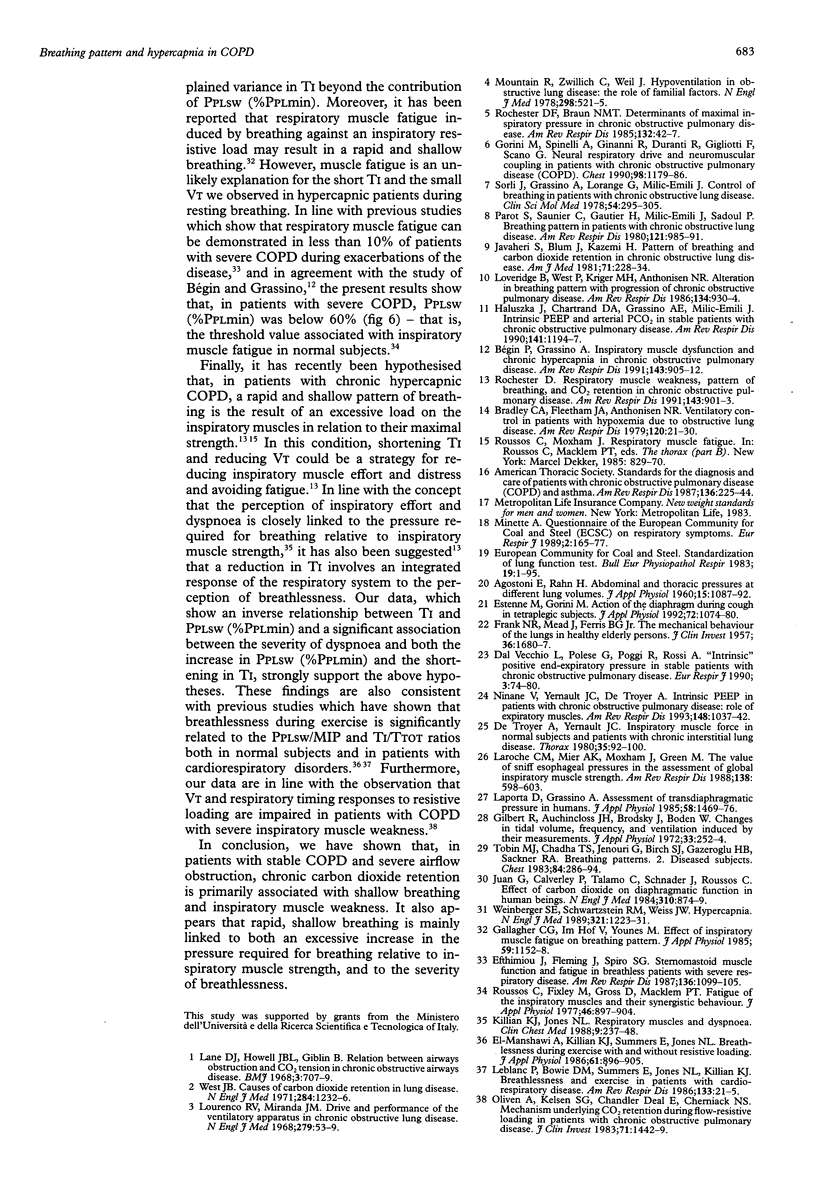
Selected References
These references are in PubMed. This may not be the complete list of references from this article.
- AGOSTONI E., RAHN H. Abdominal and thoracic pressures at different lung volumes. J Appl Physiol. 1960 Nov;15:1087–1092. doi: 10.1152/jappl.1960.15.6.1087. [DOI] [PubMed] [Google Scholar]
- Bradley C. A., Fleetham J. A., Anthonisen N. R. Ventilatory control in patients with hypoxemia due to obstructive lung disease. Am Rev Respir Dis. 1979 Jul;120(1):21–30. doi: 10.1164/arrd.1979.120.1.21. [DOI] [PubMed] [Google Scholar]
- Bégin P., Grassino A. Inspiratory muscle dysfunction and chronic hypercapnia in chronic obstructive pulmonary disease. Am Rev Respir Dis. 1991 May;143(5 Pt 1):905–912. doi: 10.1164/ajrccm/143.5_Pt_1.905. [DOI] [PubMed] [Google Scholar]
- Dal Vecchio L., Polese G., Poggi R., Rossi A. "Intrinsic" positive end-expiratory pressure in stable patients with chronic obstructive pulmonary disease. Eur Respir J. 1990 Jan;3(1):74–80. [PubMed] [Google Scholar]
- Efthimiou J., Fleming J., Spiro S. G. Sternomastoid muscle function and fatigue in breathless patients with severe respiratory disease. Am Rev Respir Dis. 1987 Nov;136(5):1099–1105. doi: 10.1164/ajrccm/136.5.1099. [DOI] [PubMed] [Google Scholar]
- Estenne M., Gorini M. Action of the diaphragm during cough in tetraplegic subjects. J Appl Physiol (1985) 1992 Mar;72(3):1074–1080. doi: 10.1152/jappl.1992.72.3.1074. [DOI] [PubMed] [Google Scholar]
- FRANK N. R., MEAD J., FERRIS B. G., Jr The mechanical behavior of the lungs in healthy elderly persons. J Clin Invest. 1957 Dec;36(12):1680–1687. doi: 10.1172/JCI103569. [DOI] [PMC free article] [PubMed] [Google Scholar]
- Gallagher C. G., Hof V. I., Younes M. Effect of inspiratory muscle fatigue on breathing pattern. J Appl Physiol (1985) 1985 Oct;59(4):1152–1158. doi: 10.1152/jappl.1985.59.4.1152. [DOI] [PubMed] [Google Scholar]
- Gilbert R., Auchincloss J. H., Jr, Brodsky J., Boden W. Changes in tidal volume, frequency, and ventilation induced by their measurement. J Appl Physiol. 1972 Aug;33(2):252–254. doi: 10.1152/jappl.1972.33.2.252. [DOI] [PubMed] [Google Scholar]
- Gorini M., Spinelli A., Ginanni R., Duranti R., Gigliotti F., Scano G. Neural respiratory drive and neuromuscular coupling in patients with chronic obstructive pulmonary disease (COPD). Chest. 1990 Nov;98(5):1179–1186. doi: 10.1378/chest.98.5.1179. [DOI] [PubMed] [Google Scholar]
- Haluszka J., Chartrand D. A., Grassino A. E., Milic-Emili J. Intrinsic PEEP and arterial PCO2 in stable patients with chronic obstructive pulmonary disease. Am Rev Respir Dis. 1990 May;141(5 Pt 1):1194–1197. doi: 10.1164/ajrccm/141.5_Pt_1.1194. [DOI] [PubMed] [Google Scholar]
- Javaheri S., Blum J., Kazemi H. Pattern of breathing and carbon dioxide retention in chronic obstructive lung disease. Am J Med. 1981 Aug;71(2):228–234. doi: 10.1016/0002-9343(81)90116-9. [DOI] [PubMed] [Google Scholar]
- Juan G., Calverley P., Talamo C., Schnader J., Roussos C. Effect of carbon dioxide on diaphragmatic function in human beings. N Engl J Med. 1984 Apr 5;310(14):874–879. doi: 10.1056/NEJM198404053101402. [DOI] [PubMed] [Google Scholar]
- Killian K. J., Jones N. L. Respiratory muscles and dyspnea. Clin Chest Med. 1988 Jun;9(2):237–248. [PubMed] [Google Scholar]
- Lane D. J., Howell J. B., Giblin B. Relation between airways obstruction and CO2 tension in chronic obstructive airways disease. Br Med J. 1968 Sep 21;3(5620):707–709. doi: 10.1136/bmj.3.5620.707. [DOI] [PMC free article] [PubMed] [Google Scholar]
- Laporta D., Grassino A. Assessment of transdiaphragmatic pressure in humans. J Appl Physiol (1985) 1985 May;58(5):1469–1476. doi: 10.1152/jappl.1985.58.5.1469. [DOI] [PubMed] [Google Scholar]
- Laroche C. M., Mier A. K., Moxham J., Green M. The value of sniff esophageal pressures in the assessment of global inspiratory muscle strength. Am Rev Respir Dis. 1988 Sep;138(3):598–603. doi: 10.1164/ajrccm/138.3.598. [DOI] [PubMed] [Google Scholar]
- Leblanc P., Bowie D. M., Summers E., Jones N. L., Killian K. J. Breathlessness and exercise in patients with cardiorespiratory disease. Am Rev Respir Dis. 1986 Jan;133(1):21–25. doi: 10.1164/arrd.1986.133.1.21. [DOI] [PubMed] [Google Scholar]
- Loveridge B., West P., Kryger M. H., Anthonisen N. R. Alteration in breathing pattern with progression of chronic obstructive pulmonary disease. Am Rev Respir Dis. 1986 Nov;134(5):930–934. doi: 10.1164/arrd.1986.134.5.930. [DOI] [PubMed] [Google Scholar]
- Minette A. Questionnaire of the European Community for Coal and Steel (ECSC) on respiratory symptoms. 1987--updating of the 1962 and 1967 questionnaires for studying chronic bronchitis and emphysema. Eur Respir J. 1989 Feb;2(2):165–177. [PubMed] [Google Scholar]
- Mountain R., Zwillich C., Weil J. Hypoventilation in obstructive lung disease. The role of familial factors. N Engl J Med. 1978 Mar 9;298(10):521–525. doi: 10.1056/NEJM197803092981001. [DOI] [PubMed] [Google Scholar]
- Ninane V., Yernault J. C., de Troyer A. Intrinsic PEEP in patients with chronic obstructive pulmonary disease. Role of expiratory muscles. Am Rev Respir Dis. 1993 Oct;148(4 Pt 1):1037–1042. doi: 10.1164/ajrccm/148.4_Pt_1.1037. [DOI] [PubMed] [Google Scholar]
- Oliven A., Kelsen S. G., Deal E. C., Cherniack N. S. Mechanisms underlying CO2 retention during flow-resistive loading in patients with chronic obstructive pulmonary disease. J Clin Invest. 1983 May;71(5):1442–1449. doi: 10.1172/JCI110897. [DOI] [PMC free article] [PubMed] [Google Scholar]
- Parot S., Saunier C., Gautier H., Milic-Emili J., Sadoul P. Breathing pattern and hypercapnia in patients with obstructive pulmonary disease. Am Rev Respir Dis. 1980 Jun;121(6):985–991. doi: 10.1164/arrd.1980.121.6.985. [DOI] [PubMed] [Google Scholar]
- Rochester D. F., Braun N. M. Determinants of maximal inspiratory pressure in chronic obstructive pulmonary disease. Am Rev Respir Dis. 1985 Jul;132(1):42–47. doi: 10.1164/arrd.1985.132.1.42. [DOI] [PubMed] [Google Scholar]
- Roussos C., Fixley M., Gross D., Macklem P. T. Fatigue of inspiratory muscles and their synergic behavior. J Appl Physiol Respir Environ Exerc Physiol. 1979 May;46(5):897–904. doi: 10.1152/jappl.1979.46.5.897. [DOI] [PubMed] [Google Scholar]
- Sorli J., Grassino A., Lorange G., Milic-Emili J. Control of breathing in patients with chronic obstructive lung disease. Clin Sci Mol Med. 1978 Mar;54(3):295–304. doi: 10.1042/cs0540295. [DOI] [PubMed] [Google Scholar]
- Tobin M. J., Chadha T. S., Jenouri G., Birch S. J., Gazeroglu H. B., Sackner M. A. Breathing patterns. 2. Diseased subjects. Chest. 1983 Sep;84(3):286–294. doi: 10.1378/chest.84.3.286. [DOI] [PubMed] [Google Scholar]
- Weinberger S. E., Schwartzstein R. M., Weiss J. W. Hypercapnia. N Engl J Med. 1989 Nov 2;321(18):1223–1231. doi: 10.1056/NEJM198911023211804. [DOI] [PubMed] [Google Scholar]
- West J. B. Causes of carbon dioxide retention in lung disease. N Engl J Med. 1971 Jun 3;284(22):1232–1236. doi: 10.1056/NEJM197106032842202. [DOI] [PubMed] [Google Scholar]
- de Troyer A., Yernault J. C. Inspiratory muscle force in normal subjects and patients with interstitial lung disease. Thorax. 1980 Feb;35(2):92–100. doi: 10.1136/thx.35.2.92. [DOI] [PMC free article] [PubMed] [Google Scholar]
- el-Manshawi A., Killian K. J., Summers E., Jones N. L. Breathlessness during exercise with and without resistive loading. J Appl Physiol (1985) 1986 Sep;61(3):896–905. doi: 10.1152/jappl.1986.61.3.896. [DOI] [PubMed] [Google Scholar]


